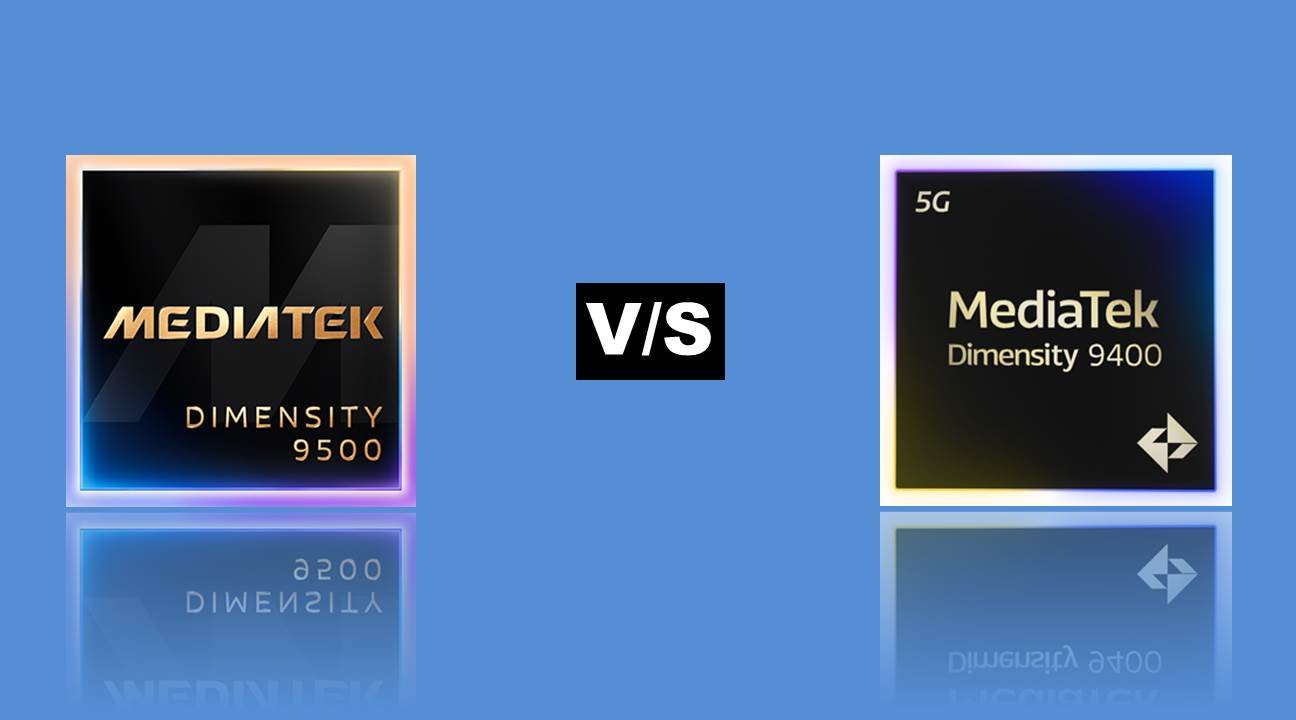
MediaTek’s Dimensity series has consistently pushed the boundaries of mobile performance, rivaling the best from Qualcomm and Samsung. With the arrival of the Dimensity 9500 and Dimensity 9400, the competition has become even tighter. Both chipsets are designed for flagship smartphones, featuring advanced 3nm processes, powerful CPUs, and cutting-edge GPUs for next-level gaming and AI experiences.
Let’s take a closer look at how the Dimensity 9500 stacks up against the Dimensity 9400 in terms of performance, efficiency, and features.
| Features | Dimensity 9500 | Dimensity 9400 |
|---|---|---|
| Announced | September 2024 | October 2024 |
| Process Node | TSMC’s 3nm (N3P) | TSMC’s 3nm (N3E) |
| CPU Cores | 8-core | 8-core |
| CPU Architecture |
|
|
| GPU |
|
|
| NPU | MediaTek NPU 990 | MediaTek NPU 890 |
| Memory | LPDDR5X up to 5.3 GHz | LPDDR5X up to 5.3 GHz |
| Storage | 4-lane UFS 4.1 | UFS 4.0 |
| Camera (ISP) |
|
|
| Connectivity |
|
|
The Dimensity 9500 brings a new custom CPU cluster configuration featuring C1-Ultra, C1-Premium, and C1-Pro cores, marking MediaTek’s step into semi-custom core architecture. With a peak clock speed of 4.21 GHz, it outpaces the Dimensity 9400, which tops out at 3.62 GHz using ARM’s Cortex-X925.
This improvement translates into faster single-core and multi-core performance, optimized for intensive tasks like 8K video processing, 3D rendering, and AI-driven operations. The 9500’s 3nm (N3P) node also ensures better efficiency and heat management compared to the 9400’s 3nm (N3E) process.
MediaTek has equipped the Dimensity 9500 with a Mali-G1 Ultra MP12 GPU, capable of delivering 120 FPS ray-traced mobile gaming. With Vulkan Ray Tracing Pipeline, MegaLights, and Nanite support in Unreal Engine, gamers can expect console-level visuals and smoother frame rates.
The Dimensity 9400 uses the Mali-G925 Immortalis MP12, which also supports ray tracing but lacks the advanced Unreal Engine integration found in the 9500. MediaTek’s HyperEngine Gaming Technology is present in both, but the 9500’s MRFC 3.0 technology gives it an edge in sustained performance and thermal control during prolonged gaming sessions.
The Dimensity 9500’s NPU 990 represents a generational leap over the NPU 890 found in the 9400. It offers faster AI computation for on-device tasks like camera scene recognition, voice assistants, and background optimization. The new NPU also supports enhanced mixed-precision operations, making it ideal for AI-driven photography and AR experiences.
Both chipsets boast impressive camera capabilities, supporting up to 320MP sensors and 8K video recording. However, the Imagiq 1190 ISP in the Dimensity 9500 introduces 4K/120fps EIS and 4K/60fps cinematic capture, features absent in the 9400’s Imagiq 1090 ISP.
Additionally, real-time semantic segmentation — which helps the camera distinguish between different objects and lighting conditions — works faster and more accurately on the 9500 due to its stronger NPU and upgraded ISP pipeline.
In connectivity, both chipsets are on par with 3GPP Release-17 5G, Wi-Fi 7, and Bluetooth 6.0 support. However, the Dimensity 9500 slightly edges ahead with a 7.4 Gbps 5G peak download speed compared to the 9400’s 7 Gbps. Its 4-lane UFS 4.1 storage also provides faster read/write performance, improving app load times and file transfers.
The MediaTek Dimensity 9500 is clearly the more powerful and refined chipset between the two. With its custom CPU cores, higher clock speeds, advanced GPU, upgraded AI engine, and superior camera support, it offers a significant performance boost over the Dimensity 9400.
While the Dimensity 9400 remains an excellent flagship option with solid gaming and AI features, the 9500 stands out as MediaTek’s true next-generation powerhouse — perfect for 2025 flagship smartphones demanding ultra-high efficiency, AI intelligence, and console-grade gaming performance.
Via: (Source)
Comments